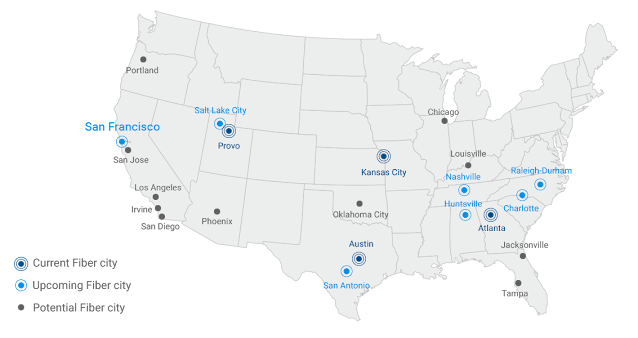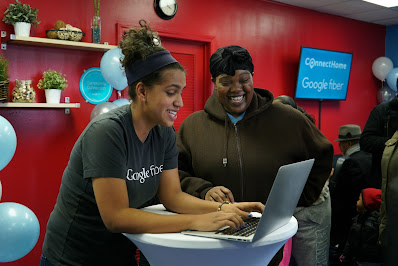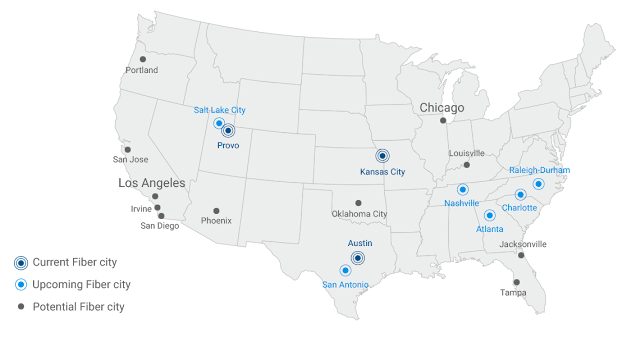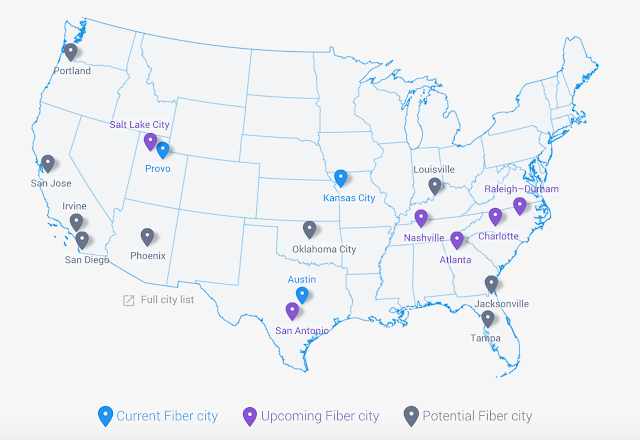Guest post from Deb Socia, Executive Director, Next Century Cities announcing the winners of the first-ever Digital Inclusion Leadership Awards.
With access to the Internet, people can search for jobs, take online classes, and connect with family — the Web can help citizens engage more deeply with their community. Across the U.S., city governments are recognizing the value of bringing more people online and taking bold actions to bridge the digital divide in their community—we want to recognize and celebrate these ideas. Today, at the Congress of Cities event in Nashville, TN,
Next Century Cities and the
National League of Cities, in partnership with Google Fiber, are announcing the winners of the first-ever
Digital Inclusion Leadership Awards.
The awards program consists of two categories: 1) Leader in Digital Inclusion Best Practices and 2) Most Promising New Plan. Within each category, we selected two overall winners and one additional winner for the most innovative project. These cities have launched computer labs throughout their communities, created specialized digital training programs, and awarded millions of dollars in funding to local organizations. Meet the inaugural winners who are tackling the digital divide in their community:
Leader in Digital Inclusion Best Practices
Philadelphia, PA: The City of Philadelphia recognizes that Internet access is a key part of anti-poverty initiatives. Through the
KEYSPOT program, the city has provided 50 computer labs to residents throughout Philadelphia. In just four years, public computers at these centers have been used more than 750,000 times to help low-income, homeless, and senior residents apply for government benefits, file taxes, and apply for jobs.
Learn more.
Seattle, WA: In 1997, the City of Seattle launched the
Technology Matching Fund (TMF), providing funding and technical resources to support more than 150 local organizations. TMF is linked closely with the City’s Race and Social Justice Initiative, and participating organizations have helped residents create resumes and use email for the first time. With $3.9 million in funding and resources, TMF has reached more 43,000 Seattle residents over the program’s lifetime.
Learn more.
Most innovative — Davidson, NC: Inspired by 12-year-old Franny Millen, who wanted to help more of her classmates access the Internet at home,
Eliminate the Digital Divide (E2D) has provided homes with school-aged children in Davidson a computer and access to Internet. Mayor John Woods also named every second Saturday in May “E2 Lemonade Day” to support grassroots fundraising efforts, and has helped organize digital literacy classes for the community.
Learn more.
Most Promising New Plan
Austin, TX: The City of Austin’s
Unlocking the Connection program addresses multiple barriers to getting online at home. In partnership with the Housing Authority of the City of Austin (HACA), Google Fiber, Austin Community College and other community organizations, the city will connect Austin’s 18 public housing communities, provide classes on how to use the web, and give refurbished computers to any resident who completes the digital training course. The City’s Grant for Technology Opportunity Program provides funding to upgrade onsite computer labs.
Learn more.
Chattanooga, TN: Adapted from a successful initiative in Boston,
Tech Goes Home Chattanooga (TGH CHA), trains staff and leaders at schools, community centers, libraries and churches how to get more people from low-income and underserved populations online. In 2016, Tech Goes Home CHA plans to reach 1,247 households by teaching computer skills classes, helping people signing up for affordable internet plans, and subsidizing chromebooks and iPads.
Learn more.
Most innovative — Washington, DC: In order to increase Internet usage in low-income neighborhoods, the city of Washington, D.C. turned an old ‘bookmobile’ into a
Mobile Tech Lab (MTL) by outfitting it with computers and Wi-Fi. Local nonprofit partners provide classes on the MTL as it visits neighborhoods with limited access to broadband. As part of the city’s Connect.DC program, residents complete computer trainings and pursue long-term goals, such as earning a GED.
Learn more.
Posted by Deb Socia, Executive Director, Next Century Cities
*A note on the selection process: Applicants were evaluated by a committee including one representative each from Next Century Cities, National League of Cities, Google Fiber, National Council of La Raza, National Telecommunications and Information Administration and Smart Chicago. The Leader in Digital Inclusion Best Practices category recognizes digital inclusion efforts that have been operational for over one year, and the Most Promising New Plan category recognizes planned or incipient efforts that have been operational for less than a year. Winners were chosen based on their program’s ability to provide training, access, and hardware to a diverse range of participants, at low cost, with proven results and community engagement. We received 30 applications for these awards.







